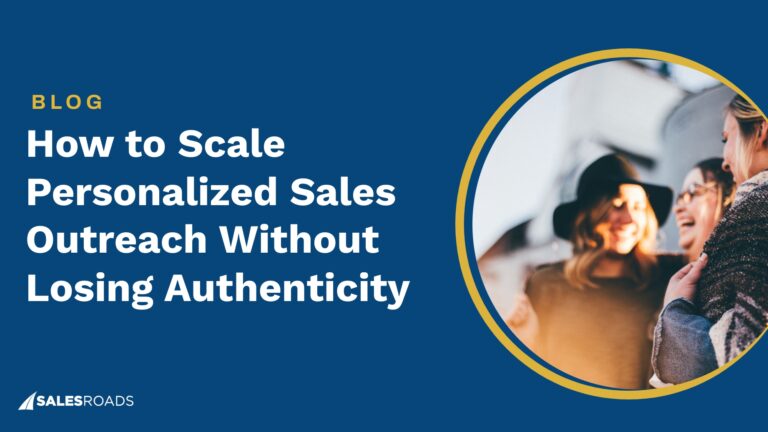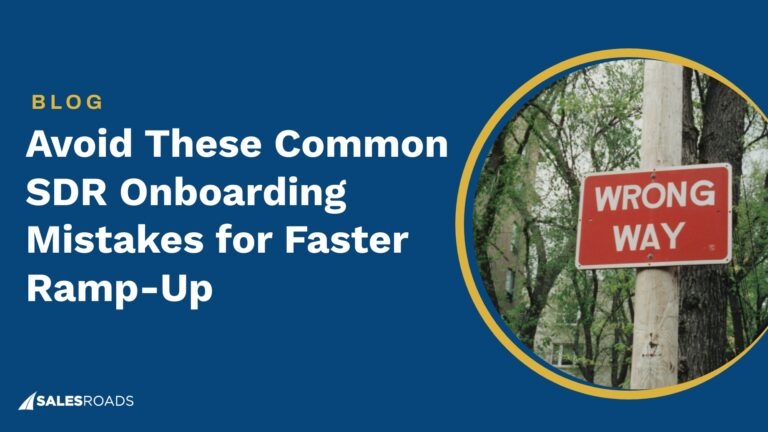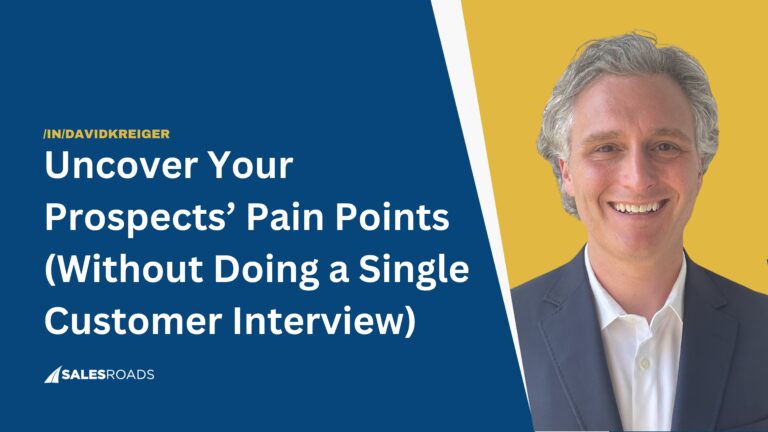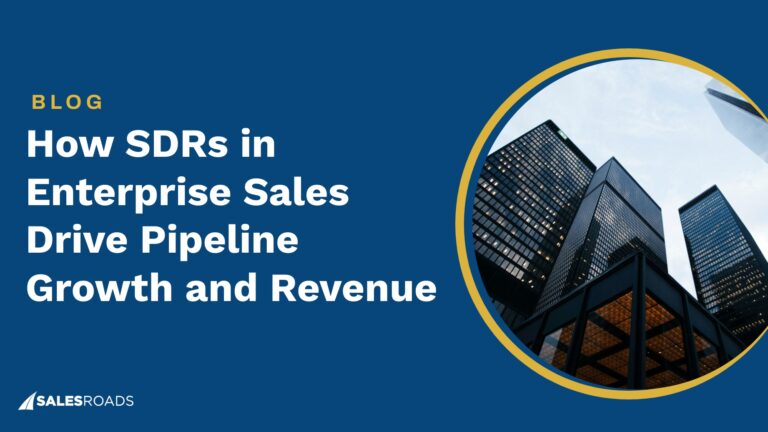Organic lead generation is about naturally drawing in potential clients through engaging content, smart SEO, and genuine interactions. It earns attention by fostering a sense of trust and expertise that paid advertising can’t match.
Ignoring this vital strategy can spell disaster for businesses in today’s market, where authenticity and informed choices are prized. Failing to focus on organic lead generation can leave your business lagging behind, struggling to make meaningful connections.
The Importance of Organic Lead Generation in B2B Sales
Organic lead generation is not just about attracting leads; it’s about building credibility and trust, which are the bedrock of successful B2B relationships. Unlike paid lead generation methods, which can offer quick visibility but often lack depth, organic lead generation nurtures a deeper connection with potential clients.
Organic strategies help establish your brand as a trusted authority in your field. This is crucial in B2B contexts, where decisions are typically informed by expertise and reliability.
Organic lead gen offers many benefits, including:
Cost-effectiveness compared to paid advertising
While paid advertising often requires a significant upfront investment with ongoing costs, organic lead generation typically demands less financial input over time. This is a crucial consideration for businesses, particularly those operating with limited budgets or seeking a higher ROI.
The beauty of organic lead generation lies in its ability to leverage existing resources, such as your company’s website, blog, or social media platforms. By optimizing these assets for search engines and engaging with your audience through valuable content, you can attract leads without the constant need for financial outlay associated with paid ads.
Building long-term customer relationships
Organic lead generation strategies excel in their ability to foster stronger, long-term relationships with customers, a critical aspect in the B2B sector. This approach is rooted in providing value first, rather than pushing for a sale. By focusing on the needs and interests of your target audience and offering solutions through your content, you naturally attract and engage potential clients who are genuinely interested in what you have to offer.
Content that educates, informs, or solves problems helps establish your brand as a helpful and knowledgeable industry leader. This kind of relationship-building is at the heart of organic lead generation. When potential clients consistently find value in your content, trust is built. Over time, this trust translates into credibility for your brand, laying the foundation for a lasting business relationship.
Enhanced credibility and trust in your brand
Organic lead generation methods, particularly content marketing and social media engagement, play a pivotal role in enhancing the credibility and trustworthiness of your brand among potential clients. These methods are not just about broadcasting a sales message; they’re about establishing your brand as an authoritative voice in your industry.
Content marketing, for instance, allows you to share your expertise and insights with your audience. By consistently providing valuable, high-quality content that addresses industry issues, answers common questions, or offers solutions, you position your brand as a thought leader. This thought leadership is crucial in the B2B space, where decisions are often based on expertise and knowledge.
Higher quality leads with better conversion rates
The quality of leads generated through organic methods significantly surpasses those acquired via paid channels, leading to better conversion rates. This difference in quality stems from how these leads are obtained.
Organic leads are typically more targeted because they result from users actively seeking information or solutions that your brand provides. When a potential client finds your company through a search engine or through informative content you’ve published, they already have a certain level of interest and intent. This pre-existing interest means that these leads are more likely to be in the consideration or decision stage of the buying process, making them more primed for conversion.
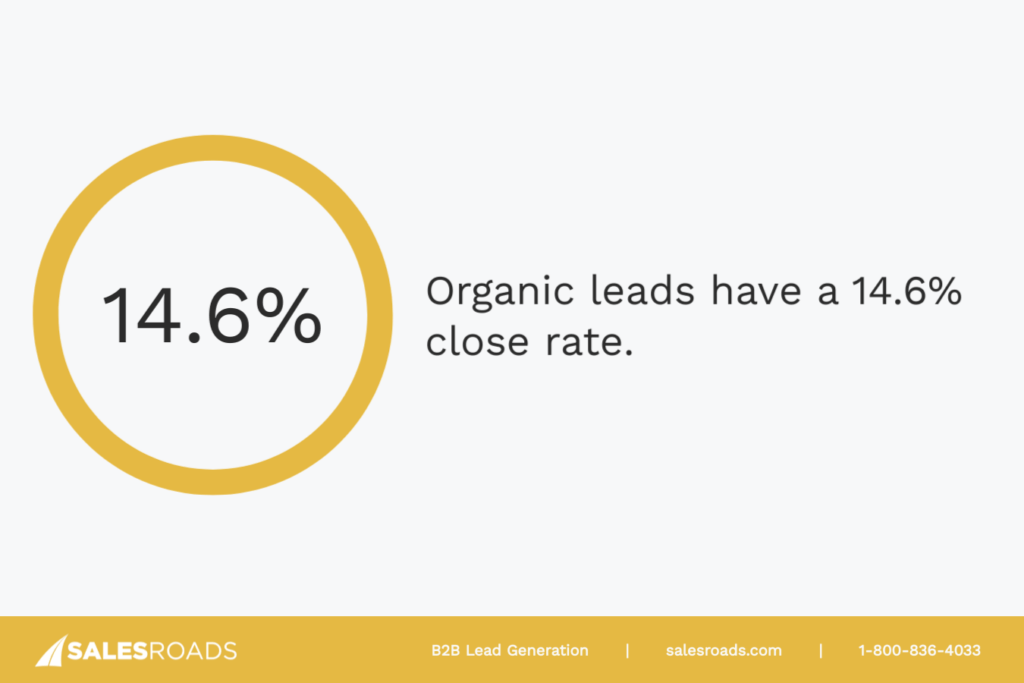
A compelling statistic highlights this advantage: “Organic leads have a 14.6% close rate, compared to 1.7% for outbound marketing leads.” This stark contrast in close rates underscores the effectiveness of organic lead generation in not just attracting leads but also attracting the right kind of leads.
Sustainable and continuous lead flow
Organic lead generation strategies are renowned for their ability to provide a sustainable and continuous flow of leads, a stark contrast to the often temporary boost provided by paid campaigns. The sustainability of organic methods lies in their foundational approach to building and maintaining a presence in your target market.
One of the key aspects of organic lead generation is its cumulative effect. Strategies like SEO, content marketing, and social media engagement don’t just bring immediate results; they build upon themselves over time. For instance, a well-optimized blog post can continue to attract visitors and generate leads months or even years after it was originally published. This enduring presence in search engine results and ongoing relevance to your audience ensures a steady stream of leads.
Greater ROI in the long term
Organic lead generation strategies are often associated with a slower start, particularly when compared to the immediate impact of paid advertising. However, it’s important to recognize that these organic methods typically yield a higher ROI over the long term. This greater ROI is a result of the compounding effects of organic strategies and the enduring value they bring.
While organic strategies may take time to gain momentum, once they do, they often continue to generate leads without the need for continuous investment. For example, a well-optimized piece of content can continue to rank highly on search engines and attract leads for years after its initial publication. This longevity means that your initial investment keeps paying dividends far into the future, unlike paid ads which only generate leads as long as you are paying for them.
Aligning with modern buying behaviors
Organic lead generation is particularly effective because it aligns seamlessly with modern buying behaviors, especially in the B2B landscape where purchasing decisions are often thoroughly researched and considered. Today’s buyers are increasingly self-directed in their buying journey, seeking out valuable information, insights, and solutions on their own before ever engaging with a sales representative.
Demand Gen Report states that “47% of buyers viewed three to five pieces of content before engaging with a sales rep.” This trend underscores the importance of having a strong organic online presence, where potential customers can easily find and interact with your content.
Leveraging Content Marketing for B2B Organic Lead Generation
The power of content marketing lies in its ability to attract, engage, and nurture potential clients through relevant and useful information, rather than direct selling tactics.
The effectiveness of content marketing in the B2B sector is highlighted by compelling statistics: “Content marketing generates over three times as many leads as outbound marketing and costs 62% less.” This remarkable efficiency highlights not just the cost-effectiveness of content marketing, but also its potency in lead generation. By providing content that addresses the specific needs and challenges of your audience, you establish your brand as a trusted resource, paving the way for more organic leads.
Developing thought leadership through content
The essence of thought leadership is expertise. By sharing in-depth knowledge, unique insights, and forward-thinking perspectives, you demonstrate a deep understanding of your industry and the challenges your potential clients face. This could be through detailed blog posts, comprehensive whitepapers, insightful webinars, or even engaging podcasts. Each piece of content should add value, offering solutions or new ways of thinking that resonate with your target audience.
This positioning has a direct impact on lead generation. As a recognized thought leader, your content naturally attracts professionals who are seeking authoritative views and innovative solutions. These individuals are more likely to engage with your content, share it within their networks, and turn to you when they need the products or services you offer.
SEO strategies for B2B content
The visibility of your content is as crucial as its quality, and this is where search engine optimization plays a pivotal role. SEO is essential for making your B2B content discoverable to the right audience. It involves optimizing your content so that it ranks higher in search engine results for relevant keywords and phrases, thereby increasing the likelihood of your target audience finding it.
A key component of SEO is a well-thought-out keyword strategy. This involves researching and identifying the terms and phrases that your potential clients are using to search for information, products, or services in your industry. By incorporating these keywords into your content in a natural and meaningful way, you can improve your content’s relevance and visibility in search results. However, it’s important to balance keyword usage with the overall quality and readability of the content, as search engines increasingly prioritize user experience.
Another crucial aspect of SEO is staying abreast of industry trends and algorithm updates. With the advent of AI and continuous updates in search engine algorithms, the landscape of SEO is constantly evolving. AI technologies are becoming more sophisticated in understanding user intent, contextual relevance, and content quality. Therefore, it’s vital to keep your SEO knowledge up-to-date and adapt your strategies accordingly.
Mastering Social Selling on LinkedIn for B2B Organic Lead Generation
LinkedIn has emerged as a premier platform for social selling, a key component in organic lead generation strategies. This professional network, with its vast array of network-centric features, offers unparalleled opportunities for businesses looking to enhance their organic lead generation efforts.
LinkedIn stands out in the social selling arena due to its unique positioning as a professional networking site. Unlike other social media platforms, LinkedIn’s audience is primarily composed of business-minded individuals, which means the content and interactions here are more focused on professional development, industry trends, and business solutions.
Leveraging LinkedIn for social selling involves more than just posting updates about your products or services. It’s about engaging with your network, participating in industry discussions, sharing valuable content, and building relationships. By establishing yourself and your company as knowledgeable and helpful industry players, you can attract organic leads who are genuinely interested in what you have to offer.
Building and nurturing professional relationships
Effective social selling on LinkedIn is deeply rooted in the ability to build and nurture professional relationships.
Start by personalizing your connection requests with a brief note about why you’re reaching out. Once connected, engage with their content thoughtfully – comment on their posts, share insights, and contribute to discussions. Share updates about your industry, insights from your experiences, or comment on current trends.
This not only keeps you visible in your connections’ feeds but also positions you as a knowledgeable professional in your field. Remember, the goal is to be seen as a resource, not just another salesperson.
Additionally, you can take advantage of LinkedIn groups. Participate in groups relevant to your industry and contribute to conversations. This can be an excellent way to establish new connections and showcase your expertise to a broader audience.
Crafting engaging content for social selling on LinkedIn
For social selling on LinkedIn, the content you create and share is your voice in the digital marketplace. When developing content, consider what matters most to your target audience. What challenges do they face? What solutions can you offer? Educational and informative content that addresses these questions can be particularly effective.
Visual content, like infographics and short videos, can also be highly engaging on LinkedIn. They are shareable and can convey complex information in an easily digestible format. Always ensure your content aligns with your brand voice and adds real value to your audience.
Integrating social selling with LinkedIn’s advanced features
LinkedIn offers a suite of advanced features that can significantly enhance your social selling efforts. One of the most powerful tools at your disposal is LinkedIn Sales Navigator. This tool allows for more precise targeting, giving you the ability to find and connect with potential leads more effectively.
Sales Navigator offers advanced search capabilities, which let you filter prospects based on various criteria such as industry, company size, and role. This makes it easier to identify and reach out to decision-makers in your target market. Additionally, the tool provides insights into your prospects’ recent activities, interests, and mutual connections, which can be invaluable in tailoring your communication and approach.
Incorporating these advanced features into your LinkedIn strategy can significantly improve your ability to identify potential leads, understand their needs, and engage with them in a more personalized and effective manner.
Email Marketing Strategies for Nurturing B2B Leads
Email marketing stands out as a powerful tool for nurturing leads through the sales funnel. This strategy hinges on the use of targeted email campaigns, which are tailored to meet the specific needs and interests of your audience at various stages of their buying journey.
Targeted email campaigns allow for consistent and direct communication with your leads. Through regular updates, newsletters, and tailored content, you can keep your brand at the forefront of your prospects’ minds, gently guiding them through the decision-making process. This consistent touchpoint is crucial in B2B sales, where longer sales cycles and higher-stake decisions are the norm.
Personalization and segmentation in B2B email campaigns
Segmentation starts with understanding the various stages of the B2B buyer’s journey and recognizing that a one-size-fits-all approach is ineffective. Different segments of your audience may include new leads, prospects who have shown interest but haven’t purchased, and existing customers. Each of these groups has different needs and should receive content that is relevant to their specific stage in the buying process.
Personalization goes a step further by customizing the email content to the individual level. This can be as simple as using the prospect’s name in the email, or as complex as tailoring the message based on their past interactions with your brand, their industry, job role, or specific interests. Personalized emails show your leads and customers that you understand and care about their unique challenges and needs, which can significantly increase engagement and conversion rates.
Effective use of personalization and segmentation in your email campaigns can lead to higher open and click-through rates, as well as improved customer satisfaction and loyalty. By delivering the right message to the right person at the right time, you can nurture your leads more effectively through the sales funnel.
Referrals: The Power of Personal Connections in B2B
Referrals stand as a testament to the power of personal connections to organically generate high-quality leads. This method of lead generation harnesses the trust and credibility established through successful business relationships, turning satisfied clients and professional contacts into advocates for your brand.
A striking statistic sheds light on the importance of referrals in the B2B sector: “84% of B2B decision makers start the buying process with a referral.” This figure highlights the significant role referrals play in the initial stages of the buying process. When a lead comes through a referral, they bring with them a level of trust and confidence in your business, which is inherently transferred from their relationship with the referrer.
Strategies for having quality referrals
Generating quality referrals in the B2B space requires a strategic approach, focusing not just on the immediate transaction but also on building and maintaining long-term relationships.
Here are some key strategies and tips to effectively cultivate referral opportunities:
- Deliver exceptional service and value: The foundation of a good referral program is your product or service’s quality and the value it offers to clients. Ensure that your clients have exceptional experiences worth talking about. Satisfied clients are more likely to recommend your services to others.
- Maintain relationships even after a no-deal: If a deal doesn’t close, maintain the relationship. Continue to provide value, such as industry insights or helpful resources. This ongoing engagement can lead to future opportunities or referrals.
David Kreiger, the President of SalesRoads, exemplifies this approach with a standout narrative on the Daily Sales Tips podcast:
- Network actively: Attend industry events, join relevant online forums, and participate in community activities. Networking can open doors to new referral sources outside your existing client base.
Analyzing and Optimizing B2B Organic Lead Generation Efforts
Continuous analysis and optimization for your organic lead generation efforts is crucial for ensuring that your strategies remain effective, adapt to changing market conditions, and consistently yield better results.
Analyzing your lead generation efforts allows you to identify areas for improvement. For instance, if certain types of content are generating more engagement or leads, it may be beneficial to focus more resources in that direction. Conversely, if some strategies are not performing as expected, it might be time to reevaluate and adjust them.
Optimization also involves staying abreast of the latest trends and best practices. The digital landscape is constantly evolving, and strategies that were effective yesterday may not yield the same results today. Keeping up-to-date with these changes and incorporating new tactics and tools can help maintain the effectiveness of your lead generation efforts.
Key metrics to track in B2B organic lead generation
KPIs should be tailored to align with the specific channels of your organic lead generation efforts, but these are the most relevant metrics:
- Lead conversion rate: This metric measures the percentage of visitors who become leads. It’s essential for evaluating the effectiveness of your lead generation strategies in attracting and capturing interested prospects.
- Cost per lead: While organic strategies are often more cost-effective than paid advertising, it’s still important to track the cost associated with generating each lead. This includes costs related to content creation, SEO, and staff time.
- SEO performance: Metrics like keyword rankings, organic search traffic, and backlinks are crucial for understanding how well your SEO efforts are performing in terms of increasing your visibility in search engines.
- Email marketing performance: For email campaigns, open rates, click-through rates, and conversion rates are key indicators of how effectively your emails are driving engagement and leads.
Bottom Line
Organic lead generation in B2B sales is essential for building credibility, trust, and long-term customer relationships, offering a cost-effective and sustainable approach compared to paid advertising.
By leveraging content marketing, SEO, social selling on platforms like LinkedIn, and targeted email campaigns, businesses can attract higher-quality leads with better conversion rates. Constantly evolving and adapting, organic lead generation is the secret sauce for long-term ROI and sales success.
FAQs
1. How does organic lead generation differ from paid lead generation?
Organic lead generation relies on natural methods like SEO, content marketing, and social media engagement to draw in leads while paid lead generation involves directly paying for visibility, such as through ads on search engines or social media platforms. Though paid leads can offer quicker visibility, they often lack the depth and lasting engagement that organic methods provide.
2. What role does SEO play in organic lead generation?
SEO is a cornerstone of organic lead generation. It enhances the visibility of your website and content in search engine results, making it easier for potential clients to find you when they search for relevant topics or solutions. Effective SEO involves optimizing your website’s content and structure to rank higher in search results, thereby increasing organic traffic.
3. How long does it typically take to see results from organic lead generation efforts?
The timeframe to see tangible results from organic lead generation efforts can vary, but it’s generally a long-term strategy. Unlike paid advertising, which can yield immediate results, organic methods like SEO and content marketing usually take several months to a year to gain significant traction. This is because building credibility, search engine rankings, and a loyal audience takes time.
4. How does networking contribute to organic lead generation?
Networking plays a vital role in organic lead generation, especially in the B2B sector. It involves building relationships with industry peers, potential clients, and other relevant contacts. Networking can be done through attending industry events, participating in online forums, or engaging on professional social media platforms like LinkedIn. These connections can lead to referrals, partnerships, and word-of-mouth promotion, all of which are valuable organic methods to generate leads.






